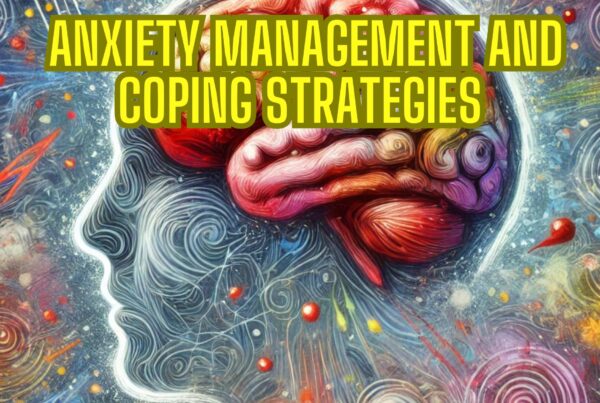The 5-4-3-2-1 Grounding Technique for Anxiety
Ask around and you’ll discover anxiety and overwhelming feelings are often experienced by many. The 5-4-3-2-1 Grounding Technique is a mindfulness tool that has been embraced by therapists and individuals alike and has proven to be useful for working with anxiety. This technique is not only simple but also effective in bringing one’s attention back to the present moment.
What is the 5-4-3-2-1 Grounding Technique?
Imagine you’re in a situation where your thoughts are racing, and your heart is pounding. It’s in these moments that the 5-4-3-2-1 Technique can be your anchor. By focusing on your five senses, this method helps divert your attention from distressing thoughts:
- Five things you can see: Look around and name five objects you can see.
- Four things you can touch: Feel the texture of objects around you.
- Three things you can hear: Listen to the sounds in your environment.
- Two things you can smell: Recognize any scents around you.
- One thing you can taste: Focus on the taste in your mouth or take a sip of a drink.
When Should You Use the 5-4-3-2-1 Grounding Technique?
The 5-4-3-2-1 Grounding Technique can be a lifeline in moments of emotional distress, helping you feel more anchored in reality. One of its greatest strengths is its versatility—it can be used whenever feelings of anxiety or overwhelm arise. Whether it’s during a stressful meeting, when you’re waiting for important news, or even in social situations that trigger discomfort, this technique gently brings your focus back to the present. By doing so, it helps reduce spiralling thoughts and creates space for calm.
It’s also an effective daily mindfulness practice, even when anxiety isn’t present. Integrating the 5-4-3-2-1 Grounding Technique into your day can help improve focus and mental clarity. Many people find it beneficial to start or end their day with this exercise as a way to reset and connect with their surroundings. Regular use can enhance your ability to remain centred and present, especially in challenging moments.
Benefits of the 5-4-3-2-1 Grounding Technique for Anxiety
The beauty of this technique lies in its simplicity. By grounding oneself in the present, a sense of calmness is often achieved. Anxiety, being a future-oriented emotion, can be tamed by bringing one’s focus to the here and now. Moreover, this technique doesn’t require any special tools or settings. Whether you’re at home, work, or even in a crowded place, it can be practiced discreetly.
The Science Behind Grounding Techniques
Grounding techniques like the 5-4-3-2-1 Grounding Technique work by engaging the senses to break cycles of anxious thinking. When anxiety takes hold, your body’s fight-or-flight response is activated, which can cause a range of physical symptoms such as a racing heart, shallow breathing, and tense muscles. Grounding techniques help shift attention from internal distress to the external world, interrupting the stress response and activating the parasympathetic nervous system—the body’s natural calming mechanism.
Research supports the effectiveness of grounding practices in managing anxiety and stress. By focusing on sensory input, you redirect the mind from overwhelming thoughts to tangible sensations. This creates a moment of pause, allowing the nervous system to regain balance and helping you respond to situations with more clarity and composure.
Common Misconceptions About the 5-4-3-2-1 Grounding Technique
One common misconception about any grounding technique is that it’s a quick fix for anxiety. While it is a powerful tool for managing acute moments of distress, it isn’t a permanent solution. Grounding exercises work best as part of a broader strategy for managing anxiety, which may include therapy, lifestyle changes, and mindfulness practices. It’s important to see this technique as one tool in a larger toolkit rather than a standalone cure.
Another misconception is that this technique works in the same way for everyone. Some individuals may find it challenging to concentrate on the five senses at first, particularly when anxiety is intense. Others may find certain steps more effective than others—perhaps focusing on sound rather than touch feels easier. The key is to practise regularly and adapt the technique to suit your needs, allowing it to become a more intuitive part of your self-care routine.
Challenges Faced While Practicing the Technique
While the 5-4-3-2-1 Grounding Technique is beneficial, it’s not without its challenges. Some individuals might find it hard to concentrate initially. Distractions, both internal and external, can make it difficult to stay focused on the senses. It’s essential to remember that like any skill, practice makes perfect. Over time, with consistent practice, the technique becomes more natural.
- Frequently Asked Questions
- Can the technique be practiced anywhere?
- Absolutely! Whether you’re in a quiet room or a bustling street, the technique can be your go-to tool for grounding.
- How often should the technique be practiced?
- There’s no hard and fast rule. It can be used whenever you feel overwhelmed or as a daily mindfulness practice.
- Is it a replacement for therapy?
- While this technique is a powerful tool, it’s not a replacement for professional therapy. If anxiety is affecting your daily life, it’s advised to seek professional help.
Anchoring In The Present
As you gain a better understanding of and managing the anxiety you experience, tools like the 5-4-3-2-1 Grounding Technique can play a pivotal role. By anchoring ourselves in the present, we can navigate the tumultuous waves of our thoughts and emotions with greater ease.
Release Hypnosis Melbourne Hypnotherapy
Since 2015, Lawrence Akers has been working under the name Release Hypnosis offering Hypnotherapy and ACT based work to the people of Melbourne or an online service. Based on St Kilda Rd, Release Hypnosis is an easy and convenient location to get to and accessible by the ANZAC station train and tram stop. Release Hypnosis can help with a wide range of presenting issues, and I offer a free 30 minute no obligation discovery call for those who are unsure if hypnotherapy is the right way forward for them.
Book Your FREE 30 Minute Consultation With Release Hypnosis NOW!
You may also like to read:
Discovering Purpose and Values: A Path to Mental Well-being
Can’t Visualise in Hypnosis? Here’s What You Can Do Instead.
Dealing with Financial Stress and Crisis: Finding Peace Amid Turbulence
What Is The Success Rate of Hypnosis?
Release Hypnosis Melbourne Hypnotherapy is accessible for people in: Abbotsford, Armadale, Albert Park, Balwyn, Bentleigh, Black Rock, Box Hill, Brighton, Brunswick, Bulleen, Bundoora, Camberwell, Canterbury, Carnegie, Caulfield, Chadstone, Cheltenham, Clayton, Coburg, Collingwood, Deer Park, Doncaster, Elsternwick, Eltham, Elwood, Epping, Essendon, Fairfield, Fitzroy, Footscray, Glen Iris, Glen Waverley, Glenhuntly, Greensborough, Hampton, Hawthorn, Heidelberg, Highet, Ivanhoe, Kew, Kooyong, Lalor, Laverton, Lower, Plenty, Macleod, Malvern, Middle Park, Moonee Ponds, Melbourne, Moorabbin, Mount Waverley, Murrumbeena, Northcote, Oakleigh, Ormond, Parkville, Pascoe Vale, Port Melbourne, Prahran, Preston, Richmond, Rosana, Sandringham, South Yarra, South Melbourne, Spotswood, St Albans, St Kilda, Surrey Hills, Templestowe, Thornbury, Toorak, Tullamarine, Williamstown, Yarraville, North Melbourne, Windsor, East Melbourne, Melbourne, Melbourne CBD, Melbourne 3004








